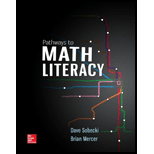
Concept explainers
When an average-sized person walks at a fairly brisk pace, he or she can burn about 100 calories in one mile. A standard weight-loss rule of thumb is that you need to burn 3,500 calories to lose 1 pound of body fat. How many miles would you have to walk per day to lose one pound in one week?
Step 1: Understand the problem. Write down the relevant information provided in the problem.
a. How many calories are burned per mile?
b. How many calories do we need to burn in a week?
Identify what we’re asked to find.
c. What exactly did the problem ask us to find?
Step 2: Devise a plan. Since we know that we need to burn 3,500 calories in a week, we can calculate how many we need to burn in one day. Then we can use that amount to figure out how many miles we’d need to walk (given that we burn 100 calories per mile).
Step 3: Carry out the plan.
d. At 3,500 calories per week, how many would we need to burn in one day?
e. At 100 calories per mile, how many miles would we need to cover to burn the number of calories found in part d?
Step 4: Check the answer.
f. With the number of miles you found in part e, how many calories would we burn in one day? In one week? Have you solved the problem correctly?
Want to see the full answer?
Check out a sample textbook solution
Chapter 2 Solutions
Pathways to Math Literacy (Loose Leaf)
- pls helparrow_forwardUse the formulas developed in this section to find the area of the figure. A= (Simplify your answer.) 8.5 m 7 T 13 m 7.7 m m 21 marrow_forwardFind the circumference and area of the circle. Express answers in terms of and then round to the nearest tenth. Find the circumference in terms of C = (Type an exact answer in terms of л.) 9 cmarrow_forward
- Find the area of the figure. A = 4 m 11 m 13 m 5 marrow_forwardFind the exact values of sin(2u), cos(2u), and tan(2u) given 2 COS u where д < u < π. 2arrow_forward(1) Let R be a field of real numbers and X=R³, X is a vector space over R, let M={(a,b,c)/ a,b,cE R,a+b=3-c}, show that whether M is a hyperplane of X or not (not by definition). متکاری Xn-XKE 11Xn- Xmit (2) Show that every converge sequence in a normed space is Cauchy sequence but the converse need not to be true. EK 2x7 (3) Write the definition of continuous map between two normed spaces and write with prove the equivalent statement to definition. (4) Let be a subset of a normed space X over a field F, show that A is bounded set iff for any sequence in A and any sequence in F converge to zero the sequence converge to zero in F. އarrow_forward
 Algebra: Structure And Method, Book 1AlgebraISBN:9780395977224Author:Richard G. Brown, Mary P. Dolciani, Robert H. Sorgenfrey, William L. ColePublisher:McDougal Littell
Algebra: Structure And Method, Book 1AlgebraISBN:9780395977224Author:Richard G. Brown, Mary P. Dolciani, Robert H. Sorgenfrey, William L. ColePublisher:McDougal Littell Glencoe Algebra 1, Student Edition, 9780079039897...AlgebraISBN:9780079039897Author:CarterPublisher:McGraw Hill
Glencoe Algebra 1, Student Edition, 9780079039897...AlgebraISBN:9780079039897Author:CarterPublisher:McGraw Hill Holt Mcdougal Larson Pre-algebra: Student Edition...AlgebraISBN:9780547587776Author:HOLT MCDOUGALPublisher:HOLT MCDOUGAL
Holt Mcdougal Larson Pre-algebra: Student Edition...AlgebraISBN:9780547587776Author:HOLT MCDOUGALPublisher:HOLT MCDOUGAL Trigonometry (MindTap Course List)TrigonometryISBN:9781337278461Author:Ron LarsonPublisher:Cengage Learning
Trigonometry (MindTap Course List)TrigonometryISBN:9781337278461Author:Ron LarsonPublisher:Cengage Learning
 Intermediate AlgebraAlgebraISBN:9781285195728Author:Jerome E. Kaufmann, Karen L. SchwittersPublisher:Cengage Learning
Intermediate AlgebraAlgebraISBN:9781285195728Author:Jerome E. Kaufmann, Karen L. SchwittersPublisher:Cengage Learning





